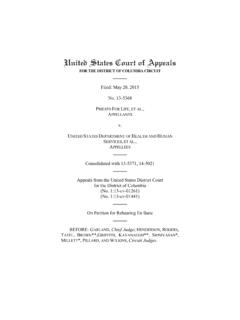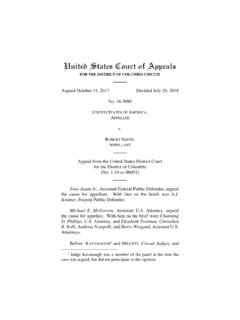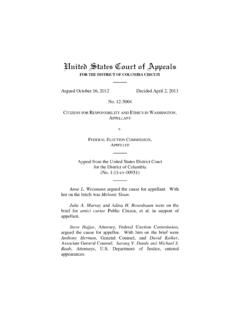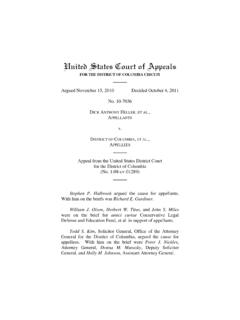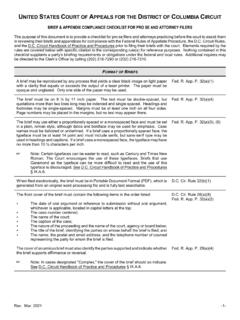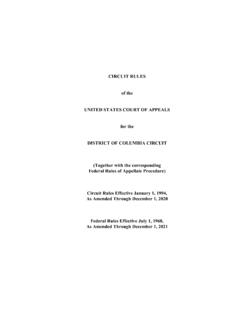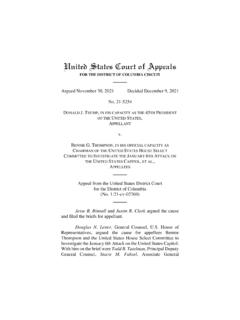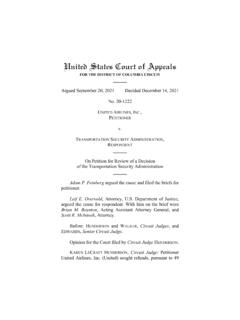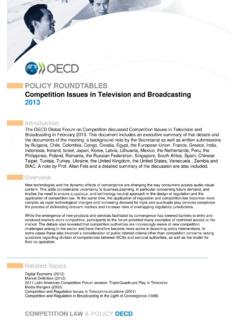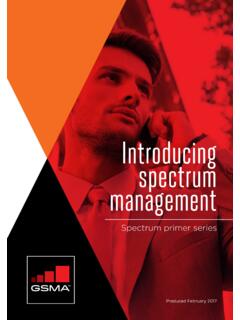Transcription of United States Court of Appeals
1 United States Court of Appeals FOR THE DISTRICT OF COLUMBIA CIRCUIT Argued September 17, 2021 Decided December 28, 2021 No. 20-1190 AT&T SERVICES, INC., PETITIONER v. FEDERAL COMMUNICATIONS COMMISSION AND United States OF AMERICA, RESPONDENTS APPLE INC., ET AL., INTERVENORS Consolidated with 20-1216, 20-1272, 20-1274, 20-1281, 20-1284 On Petitions for Review of an Order of the Federal Communications Commission Jonathan E. Nuechterlein argued the causes for petitioners Joint Issues. Mark Reddish argued the causes for petitioner APCO. With them on the joint briefs were Jeffrey S. Cohen, C. Frederick Beckner III, Rick Kaplan, Jerianne Timmerman, Craig A. Gilley, Mitchell Y. Mirviss, Elizabeth C. Rinehart, and Russell P. Hanser. Michele Farquhar, Brett Kilbourne, Jay 2 Morrison, Brian W. Murray, Delia D. Patterson, Christopher T. Shenk, and Ian D. Volner entered appearances.
2 Trey Hanbury and Jessica L. Ellsworth were on the brief for amicus curiae Southern Company Services, Inc. in support of petitioners. James M. Carr, Counsel, Federal Communications Commission, argued the cause for respondents. With him on the brief were Daniel E. Haar and Robert J. Wiggers, Attorneys, Department of Justice, Jacob M. Lewis, Associate General Counsel, Federal Communications Commission, and Thaila K. Sundaresan, Counsel. Richard K. Welch, Deputy Associate General Counsel, and Adam Crews, Counsel, entered appearances. Christopher J. Wright argued the cause for intervenors. With him on the joint brief were David Paul Murray, Russell H. Fox, Robert G. Kidwell, Paul J. Caritj, and Jason Neal in support of respondents. Rick C. Chessen and Neal M. Goldberg entered appearances. Matthew A. Brill and Matthew T. Murchison were on the brief for amicus curiae Cable Television Laboratories, Inc.
3 In support of respondents. Andrew Jay Schwartzman and Harold Feld were on the brief for amici curiae Public Knowledge, et al. in support of respondents. 3 Before: TATEL, MILLETT, and WALKER, Circuit Judges. Opinion for the Court filed by Circuit Judge TATEL. TATEL, Circuit Judge: By order dated April 24, 2020, the Federal Communications Commission opened the 6 gigahertz (GHz) band of radiofrequency spectrum to unlicensed devices routers and the devices they connect to, such as smartphones, laptops, and tablets. In doing so, the Commission required that such unlicensed devices be designed and operated to prevent harmful interference with licensees now using the 6 GHz band, , commercial communications providers, electric utilities, public safety services, and network broadcasters. Those licensees, emphasizing that existing uses of the band involve vital public safety and critical infrastructure, argue that harmful interference could nonetheless occur and that the Order therefore runs afoul of both the Communications Act of 1934 and the Administrative Procedure Act.
4 But as explained in this opinion, petitioners have failed to provide a basis for questioning the Commission s conclusion that the Order will protect against a significant risk of harmful interference, just the kind of highly technical determination to which we owe considerable deference. We therefore deny the petitions for review in all respects save one. The exception relates to the petition brought by licensed radio and television broadcasters using the 6 GHz band. Because the Commission failed adequately to respond to their request that it reserve a sliver of that band exclusively for mobile licensees, we remand to the Commission for further explanation on that point. I. Many users of the radiofrequency spectrum operate by transmitting information through microwaves short waves of 890 megahertz (MHz) or higher. See 47 4 (defining microwave frequencies). To prevent such users from interfering with one another, the Federal Communications Commission, pursuant to its authority under the Communications Act of 1934, 47 151 et seq.
5 ( Communications Act ), awards licenses to operate in specific frequency ranges, or bands. See id. 151, 301 (creating the Commission to carry out the Act s provisions and providing for licensing). Historically, the 6 GHz band, comprising frequencies between and GHz, has been reserved for licensed users that support a variety of critical services provided by utilities, commercial and private entities, and public safety agencies. Unlicensed Use of the 6 GHz Band; Expanding Flexible Use in Mid-Band Spectrum Between and 24 GHz, 35 FCC Rcd. 3852, 3855 7 (2020) ( Order ). Some of these licensees transmit signals through a fixed-microwave system, in which a transmitter on one tower beams 6 GHz signals to a receiver on another tower within its line of sight. Pet rs Br. 3. Fixed microwave systems support emergency 911 dispatch and other public safety operations, id.
6 ; commercial wireless providers, Order 7; and links for coordination of railroad train movements, control of natural gas and oil pipelines, management of electric grids, and long-distance telephone service, id. In addition to fixed microwave users, other 6 GHz band licensees operate on a mobile basis. They employ transmitters and receivers affixed to portable bases, like news vans and broadcasting cameras, and send programing from remote locations back to studios. Still others employ mobile transmitters to support wireless microphones and backstage communications. Several decades ago, the Commission, charged by Congress to generally encourage the larger and more effective use of the spectrum, 47 303(g), opened the GHz 5 and certain other bands to unlicensed radiofrequency transmitters. Today, these devices include routers and the smartphones, laptops, and tablets they support.
7 Such devices, however, must refrain from causing harmful interference with licensed users. 47 (b) (c); see also Additional Spectrum for Unlicensed Devices Below 900 MHz and in the 3 GHz Band, No. 02-380, FCC-02-328 3 4 (Dec. 11, 2002) (describing the history of unlicensed operation). Commission regulations define harmful interference as interference that endangers the functioning of a radio navigation service or of other safety services or seriously degrades, obstructs or repeatedly interrupts a radiocommunications service. 47 (m). If harmful interference occurs, the Commission may order the interfering user to cease operations. Id. (c) ( The operator of a radio frequency device shall be required to cease operating the device upon notification by a Commission representative that the device is causing harmful interference. ); see also id.
8 (c) ( [O]perators [of unlicensed devices] are required to cease operation should harmful interference occur to authorized users. ). The Commission s opening of the radiofrequency spectrum for unlicensed uses has taken on new import in recent years because of a boom in unlicensed devices that use Wi-Fi and Bluetooth technology. See Order 1. Such devices include internet access points ( , routers) and the myriad client devices that connect to them, like smartphones, tablets, and laptops. Id. 3, 12. Because these devices transmit large amounts of data, they require access to wide bands of the spectrum. The demand for wireless broadband, according to the Commission, continues to grow at a phenomenal pace; by 2024, a smartphone s average data use is projected to grow almost sixfold relative to 2018 data levels. Id. 2. 6 In 2017, responding to this growing demand, the Commission announced that it was considering opening a portion of spectrum between and 24 GHz to unlicensed use and sought public comment.
9 Expanding Flexible Use in Mid-Band Spectrum Between and 24 GHz, 32 FCC Rcd. 6373 (2017). The following year, the Commission proposed a rule that would open the 6 GHz band to unlicensed devices, again seeking public comment. Unlicensed Use of the 6 GHz Band; Expanding Flexible Use in Mid-Band Spectrum Between and 24 GHz, 33 FCC Rcd. 10496 (2018). The Commission chose the 6 GHz band in part because of its proximity and similarity to the 5 GHz band, portions of which already allowed unlicensed use. Opening the adjacent 6 GHz band would allow unlicensed devices to operate with wider channel bandwidths and higher data rates with increased flexibility. Id. 14; see also id. 19. After considering comments, the Commission, at an open meeting on April 23, 2020, adopted the Order now before us. See generally Order, 35 FCC Rcd. 3852. The Order allows unlicensed devices to operate in the 6 GHz band.
10 Because the extent to which a signal may cause interference depends in part on the signal s power, the Order distinguishes between internet access points that use standard power (like the devices that provide internet to stadiums, concert halls, and other large areas) and access points that use low power (like typical residential or office routers). The Order requires all standard-power access points to use an automated frequency coordination (AFC) system, a technology designed to ensure that unlicensed devices do not cause harmful interference with licensed devices. Id. 17. But because the AFC system requires knowing the exact operating locations and times of licensed uses, it offers little protection to licensed mobile operators, whose location can change frequently. Id. 93. For that reason, the Order prohibits 7 unlicensed standard-power access points from using those 6 GHz sub-bands in which mobile licensees operate.

